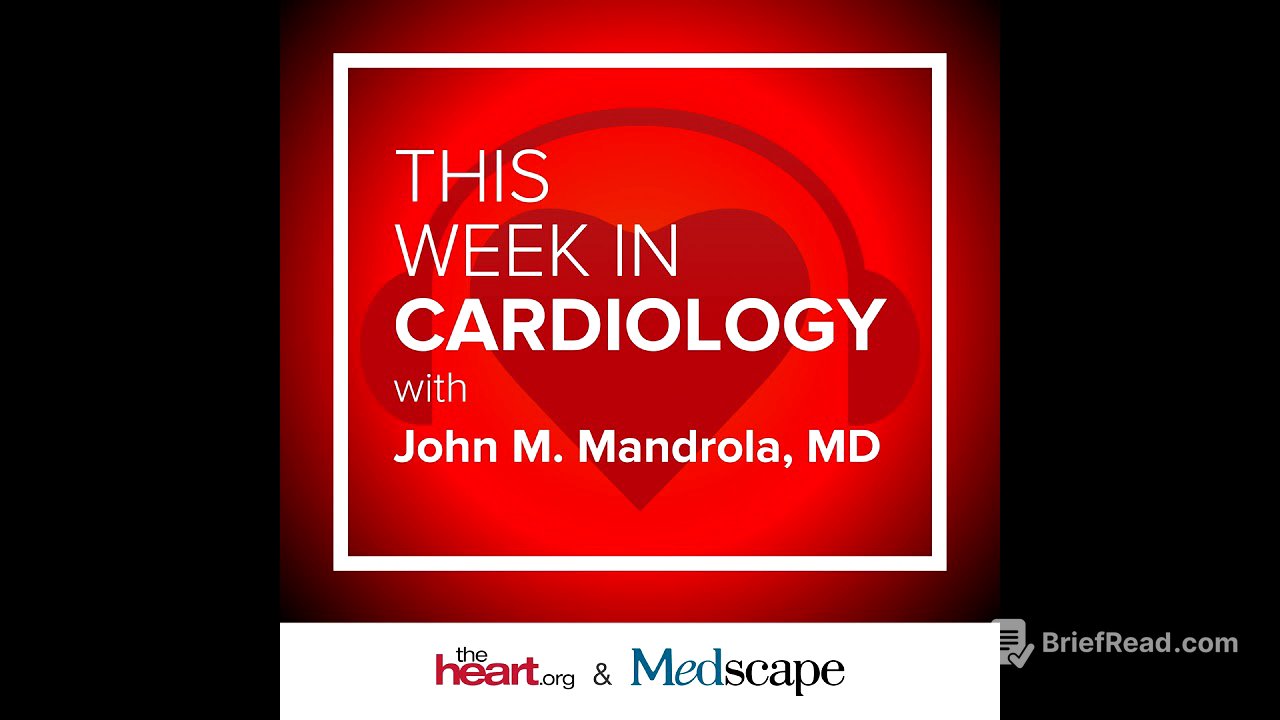TLDR;
This podcast episode of "This Week in Cardiology" covers a range of topics including listener feedback on previous discussions, the efficacy of antiplatelet and anticoagulation combinations, the potential of polypills for heart failure patients, the evolving role of physical exams with new technologies, and the challenges of interpreting underpowered clinical trials using Bayesian analysis. Key points include the limited evidence for acute anticoagulation in atrial fibrillation, the increased bleeding risk with combined antiplatelet and anticoagulation therapy post-stroke, the complexities of polypill use in heart failure, the integration of ultrasound in physical exams, and the caution needed when interpreting Bayesian analyses in underpowered trials.
- Listener feedback addresses the use of heparin in AFib, GLP-1 drugs in heart failure, and PFA for posterior wall isolation.
- The ATIS NVAF trial suggests no significant benefit from adding antiplatelets to anticoagulation in stroke patients with atherosclerosis and AFib, but it does increase bleeding risk.
- Polypills for heart failure are questioned due to the complexity of the condition and variability among patients.
- Physical exams are evolving with the integration of point-of-care ultrasound for assessing right atrial pressure.
- A Bayesian analysis of the SEGA trial on anesthesia for stroke intervention highlights the challenges of interpreting underpowered trials, even with advanced statistical methods.
Listener Feedback [0:41]
The episode begins with listener feedback on several topics. A colleague from Italy questioned the use of low molecular weight heparin for patients with atrial fibrillation (AFib) in the emergency department before switching to a direct oral anticoagulant (DOAC), highlighting the lack of evidence supporting this practice. Another listener commented on the use of GLP-1 drugs in patients with heart failure with reduced ejection fraction (HFrEF), suggesting that the combination of GLP-1 drugs and SGLT2 inhibitors might yield better outcomes, though larger trials are needed. Lastly, a co-author of a textbook on EP testing raised concerns about the use of pulsed field ablation (PFA) for posterior wall isolation due to potential hemolysis, especially with extended procedures.
Antiplatelet and Anticoagulation Combination [4:57]
The discussion shifts to the ATIS NVAF trial, a pragmatic RCT evaluating the use of antiplatelet drugs in combination with anticoagulation versus anticoagulation alone in patients with recurrent ischemic stroke or TIA, intracranial or carotid vascular atherosclerosis, or lacunar stroke and AFib. The trial, conducted across 41 sites in Japan, randomized just under 160 patients per arm to either dual therapy (antiplatelet plus DOAC) or DOAC monotherapy. The primary endpoint, a composite of ischemic cardiovascular events and major bleeding, did not significantly differ between the two groups. However, the combination therapy was associated with a significantly increased risk of major and clinically relevant non-major bleeding.
Poly Pill for Heart Failure [13:11]
The possibility of using a polypill for patients with heart failure with reduced ejection fraction (HFrEF) is examined. While polypills have shown promise in treating hypertension and cardiovascular prevention, their application to HFrEF is more complex due to the need to combine four classes of guideline-directed medical therapy (GDMT). The speaker expresses skepticism about the success of polypills for HFrEF, citing the complexity of the condition, the variability among patients, and the potential for reverse causation, where the ability to adhere to multiple medications may indicate patients who would do well regardless. Additionally, managing side effects from a polypill is more challenging than addressing side effects from sequentially started medications.
Physical Exam of the Future [16:25]
The role of physical exams in the future of cardiology is discussed, particularly the integration of point-of-care ultrasound. A study from Dallas proposed a simple four-stage classification using ultrasound to estimate right atrial pressure by assessing the internal jugular vein size relative to the carotid artery at different head elevation angles. The speaker suggests that ultrasound will replace traditional methods like stethoscope examinations and JVD assessment. The integration of large language models and AI will also transform diagnostic and treatment planning abilities, potentially empowering patients to question treatment decisions based on trial evidence.
Underpowered Trials [18:55]
The final topic addresses the challenges of interpreting underpowered trials, using the SEGA trial as an example. The SEGA trial compared general anesthesia (GA) versus moderate sedation for patients undergoing endovascular therapy for acute ischemic stroke from large vessel occlusion. The trial used Bayesian analysis to estimate the probability of treatment benefit and harm. While the trialists reported improved 90-day outcomes with GA, the wide credible intervals and the higher incidence of in-hospital mortality in the GA group raise concerns. The speaker argues that the trial's uncertainty makes it difficult to draw definitive conclusions and change practice patterns. The speaker also highlights the importance of considering the minimally important clinical difference and the probability of achieving that difference when interpreting Bayesian analyses.









